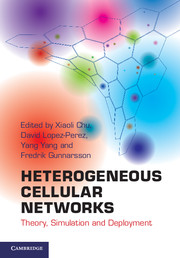Book contents
- Frontmatter
- Contents
- Acknowledgments
- Forewords
- Preface
- List of contributors
- Acronyms
- 1 Introduction
- 2 Radio propagation modeling
- 3 System-level simulation and evaluation models
- 4 Access mechanisms
- 5 Interference modeling and spectrum allocation in two-tier networks
- 6 Self-organization
- 7 Dynamic interference management
- 8 Uncoordinated femtocell deployments
- 9 Mobility and handover management
- 10 Cooperative relaying
- 11 Network MIMO techniques
- 12 Network coding
- 13 Cognitive radio
- 14 Energy-efficient architectures and techniques
- Intex
7 - Dynamic interference management
Published online by Cambridge University Press: 05 June 2013
- Frontmatter
- Contents
- Acknowledgments
- Forewords
- Preface
- List of contributors
- Acronyms
- 1 Introduction
- 2 Radio propagation modeling
- 3 System-level simulation and evaluation models
- 4 Access mechanisms
- 5 Interference modeling and spectrum allocation in two-tier networks
- 6 Self-organization
- 7 Dynamic interference management
- 8 Uncoordinated femtocell deployments
- 9 Mobility and handover management
- 10 Cooperative relaying
- 11 Network MIMO techniques
- 12 Network coding
- 13 Cognitive radio
- 14 Energy-efficient architectures and techniques
- Intex
Summary
As discussed in Chapter 1, heterogeneous cellular networks (HCNs) with low-power nodes (LPNs) are important for improving the capacity and coverage of next generation broadband wireless communication systems. However, interference problems in HCNs pose an important challenge, and thus efficient interference management techniques are required to fully benefit from their deployments. The main contribution of this chapter is to review interference problems and interference management techniques for HCNs. A general notion of macrocell base stations (MBSs) and LPNs is adopted, but the simulations are based on Long Term Evolution (LTE) scenarios with macro eNBs and pico eNBs or femto HeNBs. More specifically, cell-selection and interference coordination methods are discussed, including mechanisms recently proposed in the 3rd Generation Partnership Project (3GPP) LTE, and their performances are evaluated through system-level simulations. In such simulations, LTE-specific notation is used, and macrocell user equipment (MUE) and picocell user equipment (PUE) denotes UEs served by macro eNBs and pico eNBs, respectively.
This chapter is organized as follows. First, Section 7.1 reviews the main reasons for excessive intercell interference in HCNs. In Section 7.2, due to its significance, range expansion (RE) for HCNs is treated in more detail. Some example simulation results that demonstrate the downlink (DL)/uplink (UL) coverage imbalance in heterogeneous deployments are also provided. Section 7.3 gives a high-level overview of intercell interference coordination (ICIC) methods that are applicable to HCNs, and the next three sections are dedicated to specific ICIC approaches: frequency-domain, power-based, and time-domain ICIC techniques are discussed in Section 7.4, Section 7.5, and Section 7.6, respectively.
- Type
- Chapter
- Information
- Heterogeneous Cellular NetworksTheory, Simulation and Deployment, pp. 179 - 216Publisher: Cambridge University PressPrint publication year: 2013
- 1
- Cited by



